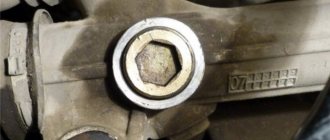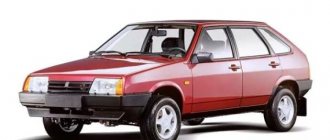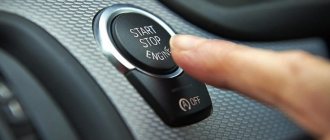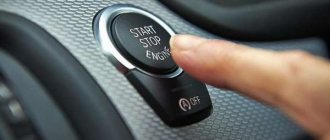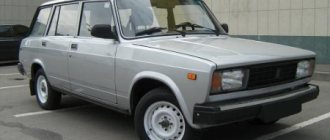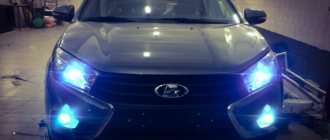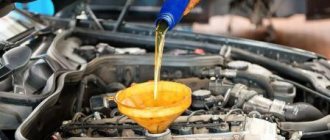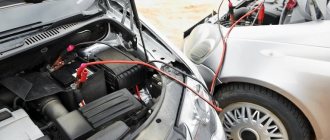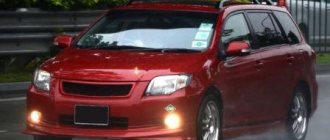During the operation of the car, quite often problems arise with starting the engine. In this case, often the engine itself and its systems are in perfect order, but the car cannot be started due to a discharged battery or problems with the starter.
In a situation like this, when the engine does not start, there are several options left:
- charge or change the battery;
- light a car;
- deliver the car to the repair site using a tow truck or on a “cord”;
- try to start it "from the pusher" and get there under your own power.
The last method is the fastest and easiest, but there are certain difficulties. You need to know how to properly start a car from a pushrod, what speed to accelerate the car to before starting, what gear to engage, whether it is even possible to start an automatic transmission from a pushrod, etc. Read more in our article.
Why doesn't the engine start?
First of all, before starting a car with a pusher, it is important to understand the reasons for the engine’s failure to start. In other words, attempts to start the engine from a pusher will not work if:
- the power unit is faulty;
- no fuel supply;
- ignition does not work;
- control electronics have failed, etc.
In other cases, when the engine is fine and there is fuel, but after turning the ignition key the starter does not turn the engine, the push start method may help. The main task is to spin the crankshaft not with the starter, but by rotating the wheels, that is, through the connected transmission.
Conditions for successful launch
The car engine is started by rotating the crankshaft with a starter powered by battery energy. If turning the key in the ignition switch results in silence or the sound of the starter working hard, it is recommended to stop trying so as not to completely drain the battery. The higher the charge level, the greater the chance of starting the engine.
To prevent pushing a car from turning into a grueling physical exercise and to produce results, consider the following points:
- It is unacceptable to start a car with an automatic transmission from a pusher and is fraught with expensive repairs.
- The number of assistants must correspond to the weight of the machine. If 2 people (including the driver) can push a small car, then an SUV or minibus requires 4–5 helpers.
- Before forcibly starting a car equipped with a carburetor power system and a mechanical fuel pump, be sure to pump up the fuel manually.
- Levers for manual pumping are also found on old diesel engines with a mechanical injection pump (stands for high pressure fuel pump). Use this handle to pre-pressurize the line.
- The injector and the new diesel engine, equipped with an electric pump, are very difficult to push and start “cold” if the battery charge is close to zero.
The last point requires clarification. For normal operation of diesel and injection nozzles, the electric fuel pump creates a certain pressure in the line. During long periods of machine inactivity, it gradually decreases. When the battery is completely dead, when the ignition is turned on, there is not enough energy to operate the pump, and the pressure in the system remains low. To lift it, you need to spin the generator, that is, you will have to push the car for a long time or drag it in tow. Sometimes it's easier to find a working battery .
The warning regarding cars with automatic transmission is not unfounded. It is useless to forcibly rotate the gearbox shafts from the wheel side - without oil pressure, the input shaft will not engage with the crankshaft. Unless you accelerate the car to a speed of 50 km/h and turn on the Drive mode, which will lead to instant failure of the friction discs. It is strictly not recommended to carry out such experiments - the launch is carried out exclusively from the battery.
Risks when starting the engine “from a pusher”
Before considering how to push start a car with different types of transmission, it is important to know the dangers of push starting in general. First of all, you should start the car using this method only in extreme cases. The fact is that even with a successful launch, the load on individual elements increases greatly:
- The first to suffer is the alternator belt and timing belt. In some cases, the alternator belt may break immediately. To minimize the start-up shock, do not engage 1st gear, starting the engine only in second.
- The timing belt can also break if the jerk is too sharp and strong. To reduce the risk of its breakage, you need a smooth change in the speed of rotation, which is impossible when starting from a pusher.
- Frequent launches from a pusher can damage the drives of other mounted units, as well as the catalyst (residues of unburnt fuel quickly damage the catalytic converter).
Towing a car
To start a manual car using this method, you will need a reliable tow rope, or, in extreme cases, a strong rope. Its ends should be tied to the load-bearing elements of the body or chassis. In a towing vehicle, this is a special eye, towbar or rear spring mount. Also hook your car to the front bracket or one of the levers.
The engine starts in the same order as a push start:
- Turn the key to the ignition position, press the clutch pedal and place the gearshift lever in 3rd gear.
- Give the signal to the driver of the front car to start moving.
- At a speed of 20–25 km/h, engage the clutch by releasing the pedal.
- As soon as the engine starts, depress the clutch again, signal to your assistant and brake both cars. While you begin to unhook the cable, do not turn off the engine.
Important point. Before you start your car, agree with the driver of the towing vehicle about the signs and actions to be taken. Let the go-ahead signal (visible in the mirror) serve as a signal for the start of movement; a successful start - a sound signal. Only you must brake and stop both cars, otherwise there is a danger of flying into the trunk of the front car.
How to start with a pushrod: mechanic's box
Provided you have a manual transmission, it is enough:
- push the car in neutral gear;
- after reaching a certain speed, turn on the ignition (turn the key in the lock); depress the clutch and engage a lower gear;
- release the clutch, after which the engine should start;
It is important that before engaging the gear, the car reaches the required speed, which will be sufficient to turn the crankshaft and start the engine. If the driver pushes the car himself, he needs to turn on the ignition, put the gearbox in neutral, open the door, and push into the A-pillar.
When the car picks up a speed of about 5-7 km/h, while driving you will need to jump into the car, squeeze the clutch and engage 2nd gear, release the clutch while simultaneously pressing the gas pedal. Then the car will jerk and the engine will start.
If a car is being pushed on a flat road, you should not expect that the car will roll due to inertia. This means that the gear must be engaged quickly so that the car does not have time to slow down much.
It also happens that it is not possible to accelerate a car from a pusher (bad road, limited space, etc.). In this case, you need a jack. The drive wheels are suspended and a cable is wound around the wheel.
Next, turn on the ignition, after which the wheel is spun by pulling the cable, the gear is engaged and the engine is started. The main thing is to immediately remove the hummock after starting the engine, as the wheel will begin to wrap it around itself.
Please note that in order to start from a pusher, if the car is being pushed by several assistants and the driver is sitting behind the wheel, you should take into account that it is necessary to engage the second, and not the first, gear. If the car is rolling too fast, then you may need to engage 3rd gear rather than second.
As a rule, if the car is rolling at a speed of 7-10 km, you need to engage second gear, but if the speed is higher, then engage third gear. You should also be prepared for the fact that immediately after starting the engine you need to press the gas to maintain the speed.
How to start a car alone
Having briefly understood the basic principles, we can answer this question. Then the driver will have to act independently.
The car is pushed, walking next to it, with the left door open, holding the steering wheel. After acceleration, they jump inside and quickly act in the same way as described above.
If the area is clear of other vehicles, it is easier to push from behind.
There is another option. After turning on the parking handbrake, jack up the drive wheel.
1.5 - 2 turns of a strong rope are wound onto it. When starting the ignition and second gear, you must sharply pull the cable to make the wheel spin.
If they fail, they repeat everything. If successful, turn off the gear and lower the jack.
Is it possible to push-start an automatic machine?
First of all, it is better to immediately abandon attempts to start the machine from a pusher. The fact is that automatic transmission, manual transmission and conventional mechanics are very different. In practice, when trying to start an automatic transmission using a pusher, the box can be broken. However, some manufacturers allow starting a car with an automatic transmission from a pusher, provided that a number of recommendations are followed.
- First, it is important to make sure that the manufacturer has provided this option for a specific automatic transmission;
- Typically, you can start a car with an automatic transmission only if the car is front-wheel drive. On a car with all-wheel drive, you need to remove the driveshaft;
- You can start a car automatically from a pusher only when towing with a soft hitch.
- If the engine does not start immediately, it is better to abandon the second attempt so as not to damage the transmission;
These recommendations mean that you need to take into account the nuances and know how to start a machine from a pusher. In fact, the car needs to be pulled, not pushed. Second, while the car is accelerating “on a cord,” the gearbox should be in position N. Further, after accelerating to 30 km/h (with a cold engine and automatic transmission) or up to 50 km/h (for a warmed-up engine and gearbox), you need to drive with this speed of 60 seconds (warm up the units, distribute the oil and prepare them for the jerk).
Now you need to press the gas pedal, after which the automatic transmission selector needs to be moved to position 2, 3 or D. Then, after jerking, the engine should start. After starting, you should immediately take your foot off the gas and move the lever to the N position.
If the engine does not start, this means that it was not possible to start the machine from the pusher and it is better to completely abandon further attempts to start the engine. Ignoring this recommendation may cause the timing belt to break, as well as damage to the automatic transmission itself.
Starting the engine by physical force
Physical strength means the presence of 2-3 strong men who are able to push a car. This is where this expression came from - “from the pusher”.
To do this, you need to get behind the wheel, put the gear in neutral and ask your partners to push the car to gain the maximum possible speed. At this moment, 2nd, or even better, 3rd speed is engaged and the clutch is sharply released. You can help the car quickly reach the desired speed with the accelerator.
On average, 2-3 people are able to accelerate the car to the required speed, so there shouldn’t be any problems.
How to push start a car with a robotic gearbox
A robotic transmission, unlike an automatic transmission, is more similar to mechanics. However, starting a modern robot from a pusher is quite difficult. The fact is that an electrical signal must first appear on its servo drive. In this case, such a signal arrives after the engine has been started.
The only way out is to connect a scanner or computer through the diagnostic connector, and then programmatically create an impulse to engage the gear when the car is in tow. Of course, the procedure is complex and requires equipment and skills. Just as in the case of an automatic transmission, if this is possible, it is better to immediately abandon attempts to start the car using a pusher on a robot.
We also recommend reading the article about the advantages and disadvantages of the DSG robotic gearbox. From this article you will learn about the pros and cons of DSG, as well as what to look for when choosing a car with this box.
As for older cars with simple manual transmissions, the operation of the servo drive on them depends on the oil pressure. This means that you can try to accelerate the car while towing by placing the selector in position N (acceleration to 30 km/h). Then 1st gear is engaged and the engine starts. It is important to remember that such launches can also lead to breakdown or a significant reduction in the service life of the robotic box.
Start in a car with manual transmission
The manual starts easily from the pusher, since there is a connection between the internal combustion engine and the gearbox. Turn on the ignition, accelerate, put the gearbox in the right gear - and you will be happy.
But the danger of these boxes is that due to incorrect operation of the clutch pedal, several components and parts of the transmission are damaged. You cannot drop the clutch abruptly, as the car will stall or unexpectedly, abruptly jerk away.
In both cases, the clutch will be subject to greater loads, and its service life will be noticeably reduced.
So, negative consequences are also possible with a manual transmission. You can cause significant damage to your car if you start it in ways not provided for by the rules. And this is what it leads to:
- due to the strong impact and load that occurs when the clutch is suddenly released, the clutch disc is damaged;
- the gear and synchronizer are destroyed - the reverse gear units are the weakest, so at this speed it is recommended either not to start the car at all, or as rarely as possible;
- the timing belt breaks, which is extremely dangerous on a turbocharged engine.
You need to start smoothly on the mechanics. In winter, on sand or dirt, on cars with bare tires, it is recommended to use third rather than second gear. This is necessary to prevent the wheels from slipping.
Recommendations
- Regardless of the type of gearbox, you need to be very careful when starting a car using a pushrod. Loads on the clutch or torque converter, the box/transmission itself, as well as on the engine, timing belts and chains, accessory drive belts and a number of other elements can lead to breakdowns and a noticeable reduction in service life.
- Any problems with the starter or battery must be resolved promptly and in a timely manner so that during the operation of the car there are no problems with starting the power unit.
If you had to push the car, it is important to select the right gear when trying to start the engine, and also try to minimize the jerk during such a start. We also recommend reading the article on how to properly light a car. From this article you will learn how to light a car, as well as what to pay attention to when starting it. - In some cases, especially on a car with an automatic transmission, it is easier to try to start the engine with a faulty starter by connecting the starter directly (if this is possible and the problem is related to the electrical circuits and not the starter itself). If the battery is discharged, it is better to look for a starting charger or “light” the car from another car.
Nuances for cars with injection engines
If the injection machine does not start with the starter, then it can also be started from the pusher, just like models with mechanics.
The injection engine can also be started from a pusher
The vehicle is first accelerated to a speed of 20 km/h, then 3rd gear is put in and the clutch is released. To prevent the engine from stalling, be sure to apply several presses of the accelerator.
Is it harmful to start a fuel-injected car from a pushrod, because it has a lot of complex electronics? Are the fears of the owners of such cars justified or not? Most likely, since the “manpower” starting method was still primarily used by our grandfathers and is more suitable for carburetor cars.
Usually, no problems arise with injection systems, but only if the actions are performed according to the instructions and consistently.
Before you start work, you should check the voltage in the electrical circuit and the battery (it tends to go low) - the readings should be within 12 V. If there are current surges in one direction, it is better to refuse and immediately call for help.
There are also several features of fuel-injected vehicles that need to be taken into account.
- Do not touch the gas until the engine reaches a sufficient number of revolutions. Electronics can fail if you press the accelerator with your entire foot. You need to work with this pedal carefully, acting on it with a light touch of the tip of your foot.
- People often ask: at what speed to run fuel-injected internal combustion engines. When the time comes to start the engine, it is advisable to turn on the fourth speed, or, as a last resort, the third.
- The battery must have at least some charge. If it was possible to start old cars with a carburetor with a completely “dead” battery, this is a different case. If there is not enough voltage, the main electronic devices that control the internal combustion engine will simply turn off.
Now about the risks - they still exist. An engine with an injection system is more vulnerable, so you should try to make fewer sudden movements. The timing belt is subjected to increased loads - here, if the machine is handled incorrectly, breakdowns are inevitable. In general, 16-valve engines are extremely dangerous to start with a pusher, almost like automatic machines. This is a high probability of valves meeting the pistons, and other undesirable consequences.
It is not advisable to push start a car with an injection system if:
- the battery is completely discharged;
- the gear is lower than third;
- car engine 16-valve;
- The gas distribution system is belt driven rather than chain driven.
It is better to push a car with an injection engine with several pairs of hands. However, there is no need to interfere with each other - the ideal option is 4-5 people. Two in front, three in back.
Procedure if you have an injector
If your car is equipped with an injector and an 8-valve engine, then a similar procedure is possible to start the car engine. The only thing worth remembering is that the fuel pump in injection cars is electronic, so you shouldn’t pump the gas pedal until the engine starts completely, but after stopping the vehicle, it is already possible to slightly increase the speed.
Many experts disagree on whether it is even possible to start a car equipped with an injector from a pusher. With an 8 valve engine, as mentioned above, this is possible. Although there is also a possibility that the timing belt of an internal combustion engine or, more commonly, the timing belt, may slip. But this possibility is small and the cost of eliminating such a nuisance is small.
If the engine has 16 valves, then almost all experts agree that it is better not to try to start the car using a pusher. In this case, the converter may fail or the pistons may “meet” the valves.
Self-launch
The method discussed above involves the help of people who will push the car. But different situations happen in life. There will not always be those nearby who can help push your vehicle.
Therefore, it will not be superfluous to find out how you can start the car yourself using the pusher method. Let us immediately note that the method is only relevant if you have a manual gearbox. If you have an automatic transmission rather than a manual one, it is better to immediately call a tow truck.
When you have to launch from a tug solely on your own, the driver needs to open the door on the steering wheel side, push with one hand, and hold on to the steering wheel with the other to keep the situation under control.
As soon as you manage to gain the required speed, while driving, you should carefully but quickly jump into the driver’s seat and carry out the same procedures that were described in the instructions above. Just remember that it is better to start the ignition before towing. Otherwise, it will be extremely inconvenient to do this later.
Don't forget to take into account the slope of the roadway, surface features, and even such factors as wind strength and direction. If the road section is completely clear and you cannot create obstacles for anyone, you can push from behind the car. It is easier to accelerate the car in this position because there is more support.
But when the car is heavy and the driver’s physical capabilities are not enough to tow it independently, you can use an alternative method. It seems somewhat simpler, but also has its own nuances. Here you will need to turn on the handbrake on the car, use a jack and lift the drive wheels.
Next, a harness or strong rope is wound around one of the wheels. At least one and a half to two full turns are required. Now go back to the car, turn on the ignition and shift the gearbox to the second gear position. With a sharp force you will need to pull the rope so that the wheel begins to rotate. Don't worry if you can't start the engine the first time. Try wrapping it in more layers or pulling it tighter or tighter. This method works great for many. As soon as the engine starts, shift the gearbox to neutral and lower the wheels from the jack.
It is especially relevant and convenient to use this cable winding method when you have a front-wheel drive car. This way you can use the steering wheel to turn the wheel slightly to a comfortable position. With rear-wheel drive cars, this technique works harder.
Experts recommend using the considered method with cable winding only in situations where the driver simply has no other solution. Be sure to first make sure that the machine is stable and securely mounted on the jack. Otherwise, it may be torn off and this will result in injury to a person.
Let's consider the principle of operation of a plant with a pusher from a technical point of view
Instead of relying on an electric starter motor to spin the flywheel, the homemade method of starting a car engine uses the torque generated by the friction between the tires and the asphalt, which in turn begins to rotate the axle shafts; they transmit torque through the differential(s), transfer the torque to the transmission, which is connected to the engine flywheel through the clutch disc... resulting in the engine starting.
As an example of how everything works and works, let’s take a four-wheel drive vehicle (SUV). The rotation of the wheels leads to the rotation of the axle shaft in the rear axle, which rotates the differential drive gear, and the torque is transferred to the rotation of the driveshaft.
The driveshaft rotates the transfer case, which in turn is bolted to the transmission. The transfer case begins to rotate the secondary shaft of the gearbox.
The transmission, when engaged (clutch pedal released), transmits torque to the input shaft and through the clutch disc to the engine flywheel, turning the crankshaft.
How to start a car from a pusher: description of the process and nuances
Starting a car from a pushrod is a lost art for many motorists today. But not so long ago, every self-respecting car owner knew how to start the engine without using a starter. Why was this necessary?
It’s just that earlier drivers could mainly rely only on themselves, their knowledge and skills. Often, you either had to wait too long for roadside assistance, or there was the option of not waiting for it at all. Let's say, on some remote roads in the north of our vast homeland (there were no mobile phones or they were just beginning to appear), how to call for help? We answer: there was no way to call, just to catch a ride and hope that a colleague in the steering wheel would not leave him in trouble...
But even in our advanced 21st century, with telephones and road services constantly at hand, providing towing and mobile repair services, it would be nice for motorists to know the secrets of starting the engine without the help of a starter. After all, situations on the road are different, and it’s better to have an alternative option than to rely on someone else’s virtue.
Diesel
Due to the fact that diesel engines are characterized by increased compression, when attempting such a start, the load on the timing drive greatly increases.
There is a severe shock during startup and the system chain/belt may break or stretch. This is fraught with consequences for the internal combustion engine and the need for its overhaul. A diesel engine is started from a pusher in the highest possible gear, 3 or 4. This way you can minimize the load on the drive and start the engine relatively safely.
Procedure if you have a carburetor
Carburetor engine
If your car is equipped with a carburetor, then the question of how to start a VAZ from a pusher, and a car of another brand, will not arise. But before considering the algorithm of sequential actions, you must first decide how you will set the car in motion. There are several options here:
- With the help of friends, neighbors, acquaintances, and other persons who will push your car a certain distance.
- With the participation of another vehicle and a vehicle cable.
- An ordinary roll down a mountain or slope.
- If you are confident in your strength and speed of reaction, then you can try to do it on your own. Place the lever in neutral, turn on the ignition and push the car yourself with the door open, subject to acceleration. As soon as you were able to increase the speed, you jump into the cabin while moving. Immediately depress the clutch, shift the manual transmission to third speed and quickly release the clutch. But this method is quite inconvenient.
Moreover, if you resort to the help of third parties, including when accelerating with the help of a tow rope, it is worth agreeing in advance on special identification marks so that the “helpers” can stop or stop the car at the right time.
The procedure for successfully starting the engine is as follows:
- the ignition must be turned on;
- With the clutch pedal depressed, set the gear shift knob to second or third speed. Please note that the clutch must be depressed before starting the engine;
- If the machine has a choke, then slightly loosen its lever. If it is not there, then lightly press the gas pedal several times to add fuel;
- then, using the selected option from the above, we begin the smooth movement of the car;
- as soon as the vehicle speed reaches 8 to 10 km/h, it is necessary to very carefully release the clutch pedal in order to start the engine by moving the wheels;
- If the car engine starts, then press the clutch again, stop the car and maintain engine speed at the desired level using the gas pedal or choke.
Let us remind you that this procedure is provided for cars equipped with an engine with a carburetor.
How will the automatic transmission and variator react to a push start?
When a car with an automatic transmission is started from a tow or pusher, torque is transmitted from the spinning wheels to the car engine through the automatic transmission. Accordingly, in cars with an automatic transmission or a variator, the pump begins to supply oil to the car with the engine running. That is, the connection made through the gearbox selector from the wheels to the engine will be interrupted and the car will not be able to start. Accordingly, by torturing the box, the machine can be taken out of action.
Read
12 inexpensive cars with automatic transmission
Cars with a transmission in which gear shifting is done using a servo drive can, in some cases, operate with a pusher. In particular, when pushing cars equipped with simple “robots”, for example, installed on the Lada Priora.
It is better not to conduct experiments on complex boxes (for example, DSG). And on certain models of simple robots it is necessary to start from a pusher only in exceptional cases, otherwise the service life of the gearbox will be much less than the period declared by the manufacturer.
Towing and automatic transmission
There is a lot of controversy as to whether it is even possible to push-start a car with an automatic transmission. Starting an engine with an automatic transmission has its own difficulties and nuances.
The issue is extremely controversial, and motorists have no common opinion about it. When the car is turned off, if there is an automatic transmission, there will be no rigid connection connecting the wheels and the engine. This only tells us that the towing method will be completely useless when trying to rotate the crankshaft by pushing the vehicle. That is, the piston group will remain motionless as it was. From this we conclude that the automatic transmission does not allow starting the car in this way.
